KURT F. LAUCKNER
MICROPROCESSORS AND INTELLIGENT SCULPTURE
Introduction With the inexpensive control capabilities now available via microprocessors and microcomputers, it is feasible to construct general purpose process control systems. These systems can be programmed to control a multitude of different sculptures without a tremendous investment in customized electronics. As more artists become aware of the capabilities and relative simplicity of these microcomputer systems, a new direction in artistic creation will evolve. It should be pointed out that several artists1 have already worked in this direction.2
When examining this new creative area, it will be convenient to categorize the artistic works as to their sophistication, or better yet, their 'intelligence.' Two major categories immediately evident are works which exhibit 'reflected intelligence' and those with 'internal intelligence.' The reflectively intelligent system accepts intelligent inputs to that sculpture, such as movement, temperature, light shadows, and sound, then it 'reflects' them back to the viewer in the form of sound, movement, etc. This type of sculpture does not make sophisticated decisions. The internally intelligent system, as one might guess, does indeed make intelligent decisions and 'thinks,' whatever that means! In the latter category, the microprocessor would probably be used as a controller of the sculpture and an interface to a larger computer. This is due to the magnitude of programs needed to do 'intelligent manipulations.' Figure 1 summarizes the two types of sculpture.
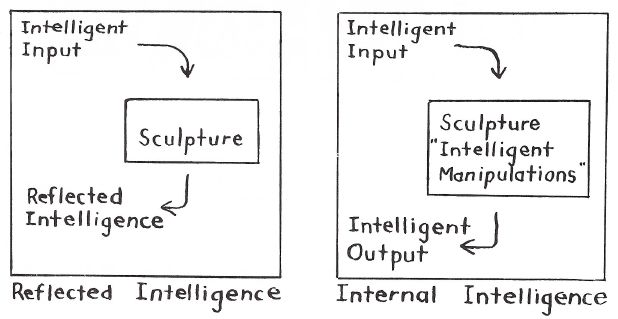
To better understand this division, it is helpful to examine a 'non-computerized' hypothetical sculpture. In the reflective case, Figure 2 shows the sculpture (a piano) with a keyboard input and sound output. The pianist's intelligent input is mechanically converted to sound and reflected back to him. An analogous intelligent sculpture could consist of a pianist, who hears the input sound from the viewer's piano and intelligently responds by playing the piano in a type of musical answer. The important feature in the latter case is that the pianist, who is part of the sculpture, is making intelligent decisions in responding to the viewer's sounds.
IS 100/B (Intelligent Sculpture, 100 Series/BIRDS)
I am currently designing two sculptures which fit the categories mentioned above. In particular, the BIRDS piece (a tentative representation is shown in Figure 3) exhibits reflected intelligence. It consists of several 'birds' which can move either up or down the pole (tree). As people observing the birds move around, movement sensors (ultrasonic-doppler shift sensors, commonly used as burglar alarms) cause the birds closest to the 'disturbance' to ascend their tree. If the movement persists after the bird reaches the top, then a rather unpleasant sound is emitted. The sculpture will force people to move slowly with caution, otherwise the disturbed birds cause unpleasant consequences. The coordination and control of the 'flock' of birds will be accomplished with a microprocessor.
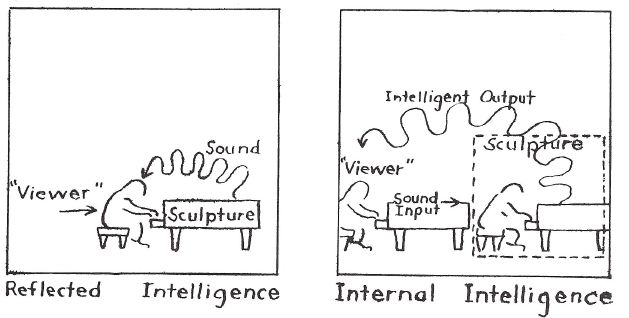
IS 400/D (Intelligent Sculpture, 400 Series/DECOY)
The second sculpture being designed is more complex. The hardware portion will consist of a 'decoy' sculpture placed in a large room as shown from overhead in Figure 4. Each viewer entering the room will wear a specially designed 'communications' helmet, which contains two independent communications systems. One system consists of an infrared transmitter and sensor. As a person looks about the room, the transmitter's signal is picked up by the sensors of the other helmets and additional fixed sensors placed in the room. A record of the individual's time and direction of observation is made for analysis by the computer. The second communications system is a low power radio transmitter which broadcasts information from the computer to each individual independently. This completes a 'closed loop' as shown in Figure 5.
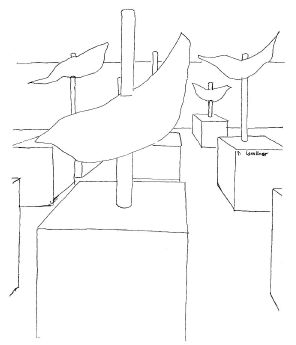
The information broadcast to each viewer is in the form of synthesized speech. To better understand the content of the message, it is helpful to make a comparison with the conversational program PARRY developed by Colby, Weber and Hilf, 1971, as described by Jackson.3
PARRY is a program designed to simulate the conversational behavior of a paranoid human being. The conversation below was produced with the program operating in its 'weak version' of paranoia. Sentences labeled 'I' are produced by the human interviewer; those labeled 'O' by the program.
I —How long have you been in the hospital?
O—About a week.
I —Are you depressed?
O—No.
I —Were you taking drugs?
O—No.
I —What is your problem?
O—People make me nervous.
I —How do they do that?
O—They stare at me.
I —Why?
O—Maybe they don't like the way I look or something.
I —Do you look unusual in some way?
O—Why are you interested in my looks?
I —Because you said people stare at you.
O—Well, sometimes.
I —How do you get along with people?
O—I don't communicate very much with the others.
I —Why not?
O—They don't realize what's going on most of the time.
I —What is going on?
O—Do you know how the underworld operates?
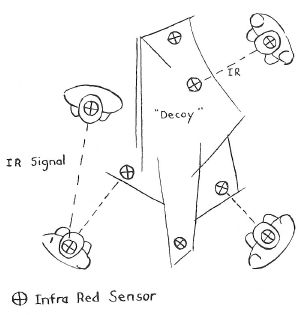
In the DECOY the input is in the form of the viewer's 'history of observation' coupled with additional information given to the sculpture's computer by a human assistant stationed within the room. This additional information would consist of various descriptors such as color of clothing, sex, physical features, helmet number, etc. The system will use this information to create various situations within the room. For example, what would you think, if suddenly everyone in the room looked at you? The reason for their stares could be the system's comment to everyone, that is, except you: "Look at that interesting cane the gentleman in the tan coat is holding." The people, their actions, and reactions are the sculpture, the physical sculpture in the room is only a decoy.
It is obvious to those working in artificial intelligence that the real problems with the construction of the sculpture are in the computer programs which make decisions about what to say to whom. The communication system, computer synthesized audio response, and other hardware features are relatively easy to construct. Of course, a large computer would be needed to do most of the analysis of information and formation of the audio response, but microprocessors would certainly be used for control purposes and as an interface to the large system. Depending on the complexity of the analysis and response programs, this could indeed be an intelligent sculpture.
Ypsilanti, Michigan
October 1975
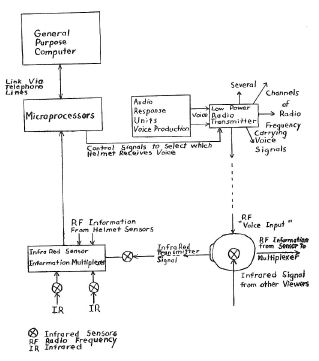
FOOTNOTES
1. The Senster, 1971, by Edward Ihnatowicz, installed at the 'Evoluon' in Eindhoven, Netherlands. (See Science and Technology in Art Today, by Jonathan Benthall, p. 78.)
2. O.C.L.E.S. (Observer Controlled Light Emission System), 1974, by William Uphoff (see page 35, newsletter of the Computer Arts Society).
3. Jackson, Philip C., Introduction to Artificial Intelligence, Petrocelli Books, New York, 1974, p. 323.
Return to Table of Contents | Previous Section | Next Section

